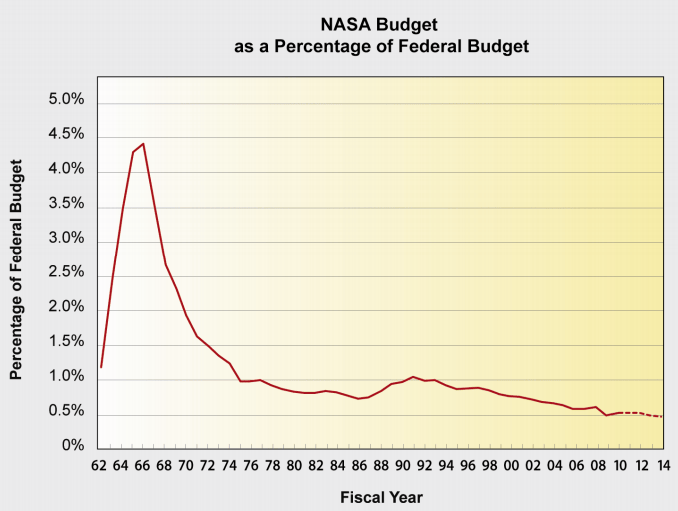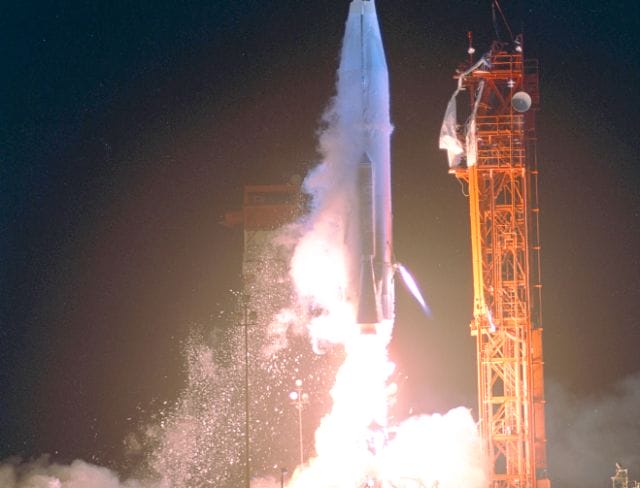On July 22, 1962, at 9:20 PM, the Mariner I sat idly on its platform, ready to make history. After investing years of construction, calculation, and funding, NASA had high hopes that its rocket would successfully conduct a flyby survey of Venus, thus shifting the Space Race’s momentum back to the home front. In every way, it was poised to set a space travel precedent.
But when the rocket embarked, it was clear there’d be no cause for celebration: less than 5 minutes into flight, Mariner I exploded, setting back the U.S. government $80 million ($630 million in 2014 dollars). The root cause for this disaster? A lone omitted hyphen, somewhere deep in hand-transcribed mathematical code.
Space Race Context
When the United States announced its intent to launch artificial satellites in 1955, the USSR countered by declaring that it would explore space “in the near future.” Two years later, on October 4, 1957, the Soviets launched Sputnik I into the annals of space history. Not to be outdone, the United States passed the National Aeronautics and Space Act in 1958, and NASA began operation. Over the next few years, the program initiated a series of launches, including the first lunar flyby (Pioneer 4, 1959), and the first weather monitoring satellite (TIROS I, 1960).
But the Soviet Union broke ground again in 1961 when astronaut Yuri Gagarin became the first human to enter space and come back to Earth safely. The following month, in an effort to rally Americans’ support of NASA, President John F. Kennedy delivered his “Urgent National Needs” speech, pledging not only to land on the moon by the end of the decade, but to devote more resources to NASA in pursuit of scientific advancement. Part of this initiative was 1962’s Mariner program.
With a budget of $554 million, the program set out to accomplish a set of interplanetary directives. Mariner I, the first of ten unmanned Mariner spacecraft, was tasked with conducting a flyby of Venus to collect a variety of scientific data (this would make it the first spacecraft to have flown by another planet). But Mariner I was doomed to fail, and would hardly even leave the launching platform.
The Most Expensive Hyphen in History
On July 22, 1962, at 9:21 AM, Mariner I was launched to great fanfare. Less than five minutes later, the mission was “forcefully aborted,” $80 million went to waste, and the potentially historical flight came crashing to the ground — all because of a tiny typo in mathematical code. On its website, NASA delineates what went wrong in the moments following the launch:
“The booster had performed satisfactorily until an unscheduled yaw-lift maneuver was detected by the range safety officer. Faulty application of the guidance commands made steering impossible and were directing the spacecraft towards a crash, possibly in the North Atlantic shipping lanes or in an inhabited area. [A range safety officer subsequently ordered its destructive abort.]”
Multiple theories emerged surrounding the reasons behind the craft’s failure, largely stemming from a bevy of reports produced in the aftermath (some official, and others merely speculation). But the most commonly cited explanation, directly from Mariner I’s Post-Flight Review Board, is that a lone “dropped hyphen or overbar” in the computer code instructions incited the flight’s demise.
Five days after the ill-fated launch, a New York Times headline harped on the minuscule typo — “For Want of Hyphen, Venus Rocket is Lost” — and the paper’s story reported that the error had been the result of “the omission of a hyphen in some mathematical data.” Purportedly, a programmer at NASA had left out the symbol while entering a “mass of coded information” into the computer system.
The same week, Richard B. Morrison, a NASA official, presented a case for the rocket’s destruction before Congress and stressed the significance of the tiny omission:
“[The hyphen] gives a cue for the spacecraft to ignore the data the computer feeds it until radar contact is once again restored. When that hyphen is left out, false information is fed into the spacecraft control systems. In this case, the computer fed the rocket in hard left, nose down and the vehicle obeyed and crashed.”
In his 1968 book The Promise of Space, Arthur C. Clarke memorialized the typo as “the most expensive hyphen in history,” a claim that is most likely true. Mariner I set the U.S. government back $80 million ($630 million in 2014 dollars) — about 7% of NASA’s $1.2 billion federal budget for 1962. If there is any consolation, it is that NASA was entering a phase where it would receive the highest allowances in its history, peaking with man setting foot on the moon in 1969:

Unfortunately, the Mariner I incident wasn’t the last time NASA lost a mission due to an easily-avoidable gaff. In 1999, the $125 million ($172 million in 2014 dollars) Mars Climate Orbiter flew off course and disintegrated after spacecraft engineers forgot to convert from English to metric measurements. While Jet Propulsion Laboratory’s navigation team used the metric system (millimeters and meters) in its calculations, Lockheed Martin Astronautics, which built the craft, provided measurements in inches, feet, and pounds.
“That was so dumb,” John Logsdon, a member of NASA’s advisory council, later told The Los Angeles Times. “There seems to have emerged over the past couple of years a systematic problem in the space community of insufficient attention to detail.” Carl Pilcher, ex-Director of NASA’s Astrobiology institute absorbed the mistake with an air of familiarity, referencing Mariner I’s 1962 plight. “People make mistakes all the time,” he said. “I think the problem was that our systems that were designed to recognize and correct human error failed us.”
In the annals of mistakes, Mariner I will forever serve as a reminder — for everyone from lowly blog editors to NASA engineers — of the universal importance of proofreading. In the meantime, we’ll take solace in the fact that our typos at Priceonomics haven’t yet set us back $80 million.
This post was written by Zachary Crockett. Follow him on Twitter here, or Google Plus here.




